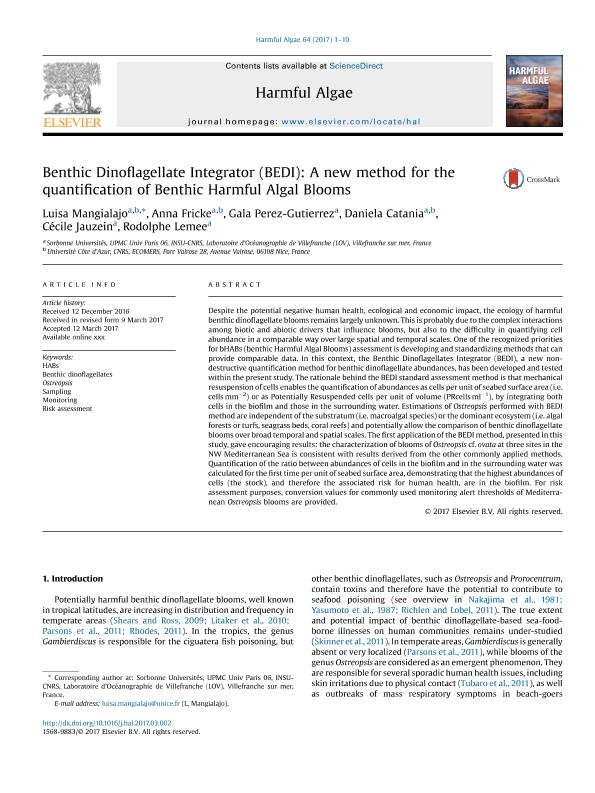Artículo
Benthic Dinoflagellate Integrator (BEDI): A new method for the quantification of Benthic Harmful Algal Blooms
Mangialajo, Luisa; Fricke, Anna Lena ; Perez Gutierrez, Gala; Catania, Daniela; Jauzein, Cécile; Lemee, Rodolphe
; Perez Gutierrez, Gala; Catania, Daniela; Jauzein, Cécile; Lemee, Rodolphe
 ; Perez Gutierrez, Gala; Catania, Daniela; Jauzein, Cécile; Lemee, Rodolphe
; Perez Gutierrez, Gala; Catania, Daniela; Jauzein, Cécile; Lemee, Rodolphe
Fecha de publicación:
04/2017
Editorial:
Elsevier Science
Revista:
Harmful Algae
ISSN:
1568-9883
Idioma:
Inglés
Tipo de recurso:
Artículo publicado
Clasificación temática:
Resumen
Despite the potential negative human health, ecological and economic impact, the ecology of harmful benthic dinoflagellate blooms remains largely unknown. This is probably due to the complex interactions among biotic and abiotic drivers that influence blooms, but also to the difficulty in quantifying cell abundance in a comparable way over large spatial and temporal scales. One of the recognized priorities for bHABs (benthic Harmful Algal Blooms) assessment is developing and standardizing methods that can provide comparable data. In this context, the Benthic Dinoflagellates Integrator (BEDI), a new non-destructive quantification method for benthic dinoflagellate abundances, has been developed and tested within the present study. The rationale behind the BEDI standard assessment method is that mechanical resuspension of cells enables the quantification of abundances as cells per unit of seabed surface area (i.e. cells mm−2) or as Potentially Resuspended cells per unit of volume (PRcells ml−1), by integrating both cells in the biofilm and those in the surrounding water. Estimations of Ostreopsis performed with BEDI method are independent of the substratum (i.e. macroalgal species) or the dominant ecosystem (i.e. algal forests or turfs, seagrass beds, coral reefs) and potentially allow the comparison of benthic dinoflagellate blooms over broad temporal and spatial scales. The first application of the BEDI method, presented in this study, gave encouraging results: the characterization of blooms of Ostreopsis cf. ovata at three sites in the NW Mediterranean Sea is consistent with results derived from the other commonly applied methods. Quantification of the ratio between abundances of cells in the biofilm and in the surrounding water was calculated for the first time per unit of seabed surface area, demonstrating that the highest abundances of cells (the stock), and therefore the associated risk for human health, are in the biofilm. For risk assessment purposes, conversion values for commonly used monitoring alert thresholds of Mediterranean Ostreopsis blooms are provided.
Palabras clave:
Benthic Dinoflagellates
,
Habs
,
Monitoring
,
Ostreopsis
,
Risk Assessment
,
Sampling
Archivos asociados
Licencia
Identificadores
Colecciones
Articulos(IADO)
Articulos de INST.ARG.DE OCEANOGRAFIA (I)
Articulos de INST.ARG.DE OCEANOGRAFIA (I)
Citación
Mangialajo, Luisa; Fricke, Anna Lena; Perez Gutierrez, Gala; Catania, Daniela; Jauzein, Cécile; et al.; Benthic Dinoflagellate Integrator (BEDI): A new method for the quantification of Benthic Harmful Algal Blooms; Elsevier Science; Harmful Algae; 64; 4-2017; 1-10
Compartir
Altmétricas



